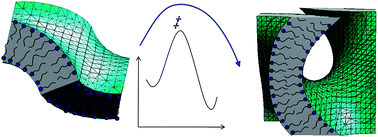Quantitative model for the kinetics of lyotropic phase transitions involving changes in monolayer curvature†
Abstract
We present a kinetic model for transformations between different self-assembled lipid structures. The model shows how data on the rates of phase transitions between mesophases of different geometries can be used to provide information on the mechanisms of the transformations and the transition states involved. This can be used, for example, to gain an insight into intermediate structures in cell membrane fission or fusion. In cases where the monolayer curvature changes on going from the initial to the final mesophase, we consider the phase transition to be driven primarily by the change in the relaxed curvature with pressure or temperature, which alters the relative curvature elastic energies of the two mesophase structures. Using this model, we have analyzed previously published kinetic data on the inter-conversion of inverse bicontinuous cubic phases in the 1-monoolein–30 wt% water system. The data are for a transition between QIIG and QIID phases, and our analysis indicates that the transition state more closely resembles the QIID than the QIIG phase. Using estimated values for the monolayer mean curvatures of the QIIG and QIID phases of −0.123 nm−1 and −0.133 nm−1, respectively, gives values for the monolayer mean curvature of the transition state of between −0.131 nm−1 and −0.132 nm−1. Furthermore, we estimate that several thousand molecules undergo the phase transition cooperatively within one “cooperative unit”, equivalent to 1–2 unit cells of QIIG or 4–10 unit cells of QIID.


 Please wait while we load your content...
Please wait while we load your content...